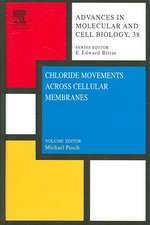Intracellular Protein Degradation: Advances in Molecular and Cell Biology, cartea 27
Editat de A.J. Rivetten Limba Engleză Hardback – 6 aug 1998
Preț: 938.23 lei
Preț vechi: 1285.24 lei
-27% Nou
Puncte Express: 1407
Preț estimativ în valută:
179.52€ • 188.45$ • 149.01£
179.52€ • 188.45$ • 149.01£
Carte tipărită la comandă
Livrare economică 10-24 aprilie
Preluare comenzi: 021 569.72.76
Specificații
ISBN-13: 9780762303878
ISBN-10: 0762303875
Pagini: 312
Dimensiuni: 156 x 234 x 19 mm
Greutate: 0.61 kg
Editura: ELSEVIER SCIENCE
Seria Advances in Molecular and Cell Biology
ISBN-10: 0762303875
Pagini: 312
Dimensiuni: 156 x 234 x 19 mm
Greutate: 0.61 kg
Editura: ELSEVIER SCIENCE
Seria Advances in Molecular and Cell Biology
Cuprins
Contents. List of Contributors. Preface (A.J. Rivett). Biochemical Properties and Biological Functions of ATP-Dependent Proteases in Bacterial Cells (M.R. Maurizi). From Proteasome to Lysosome: Studies on Yeast Demonstrate the Principles of Protein Degradation in the Eukaryote Cell (M. Thumm and D.H. Wolf). Cellular Regulation by Ubiquitin-Dependent Processes (K.D. Wilkinson). The 20s Proteasome: Subunits and Functions (K. Tanaka and N. Tanahashi). The 19s Regulatory Complex of the 26s Proteasome (W. Dubiel and M. Rechsteiner). Endoplasmic Reticulum0Associated Protein Degradation: an Unconventional Route to a Familiar Fate (A.A. McCracke, E.D. Werner, and J.L. Brodsky). Pathways for the Degradation of Intracellular Proteins within Lysosomes in Higher Eukaryotes (E. Knecht, J.J.M. de Llano, E.J. Andreu, and I.M. Miralles). The Critical Role of the Ubiquitin-proteasome Pathway in Muscle Wasting in Comparison to Lysosomal and Ca2+-dependent Systems (D. Attaix and D. Taillandier). Proteolysis in Apoptosis: Enzymes and Substrates (G.G.F. Mason, and J. Beyette). Index.





























